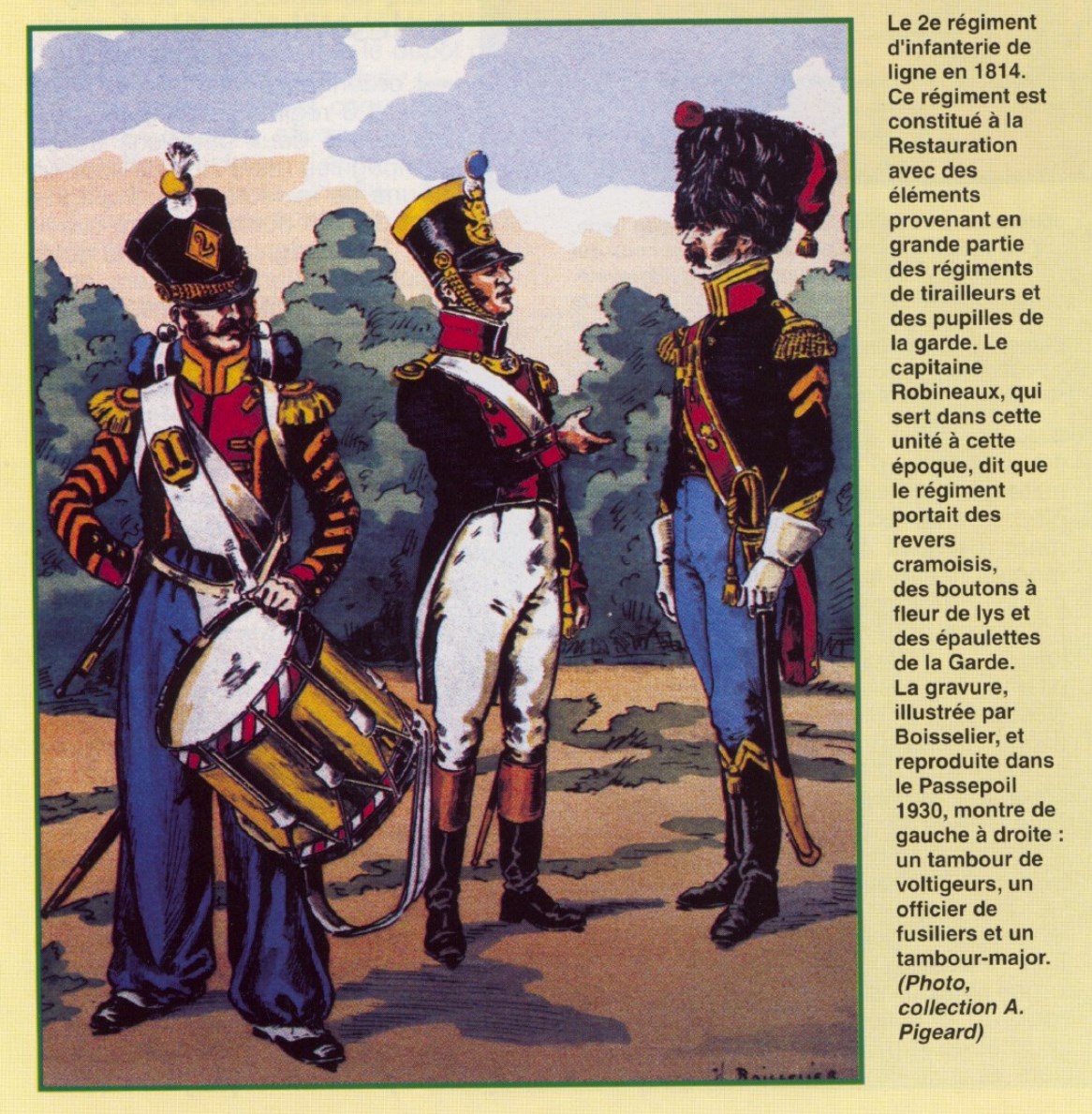
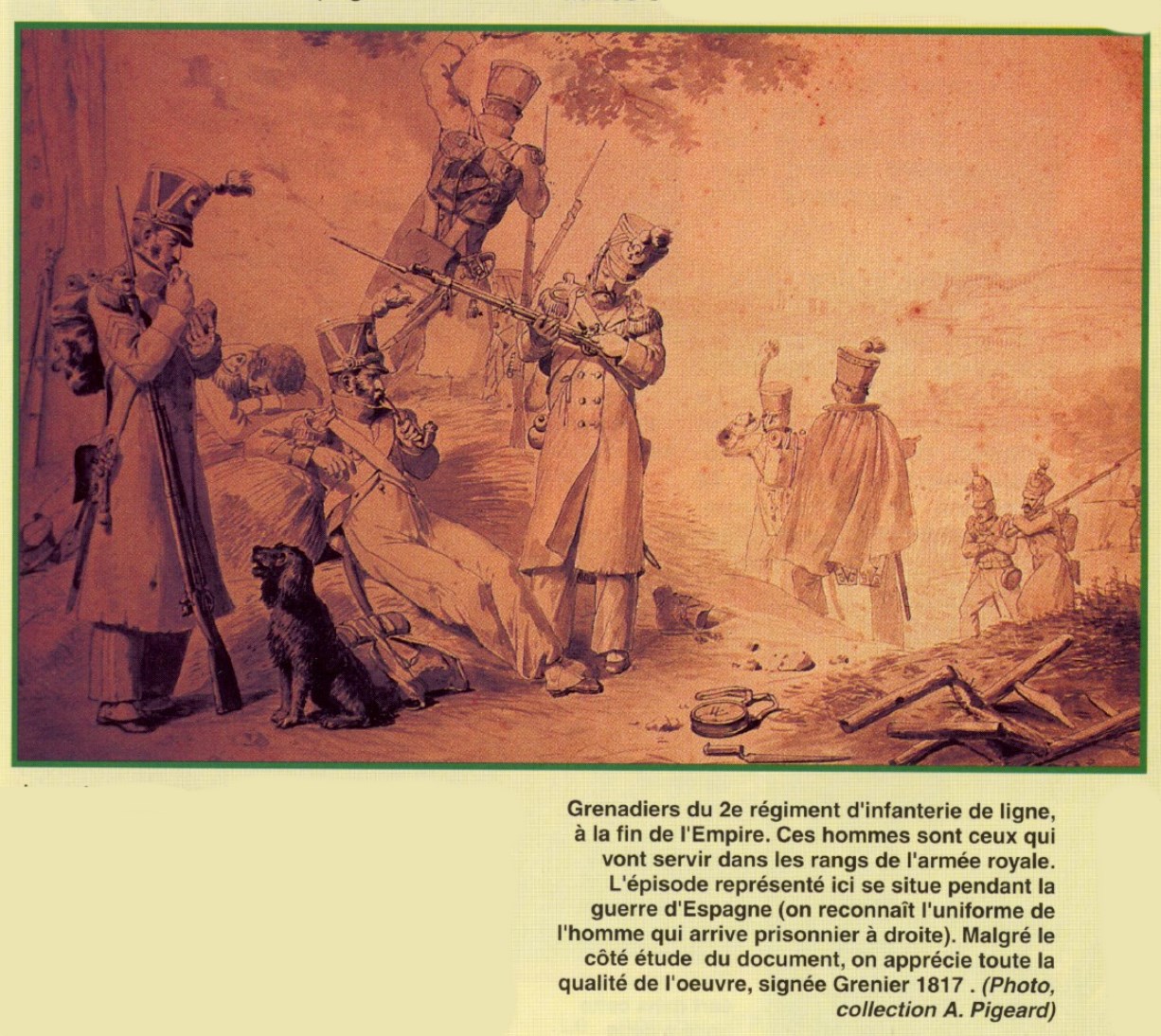
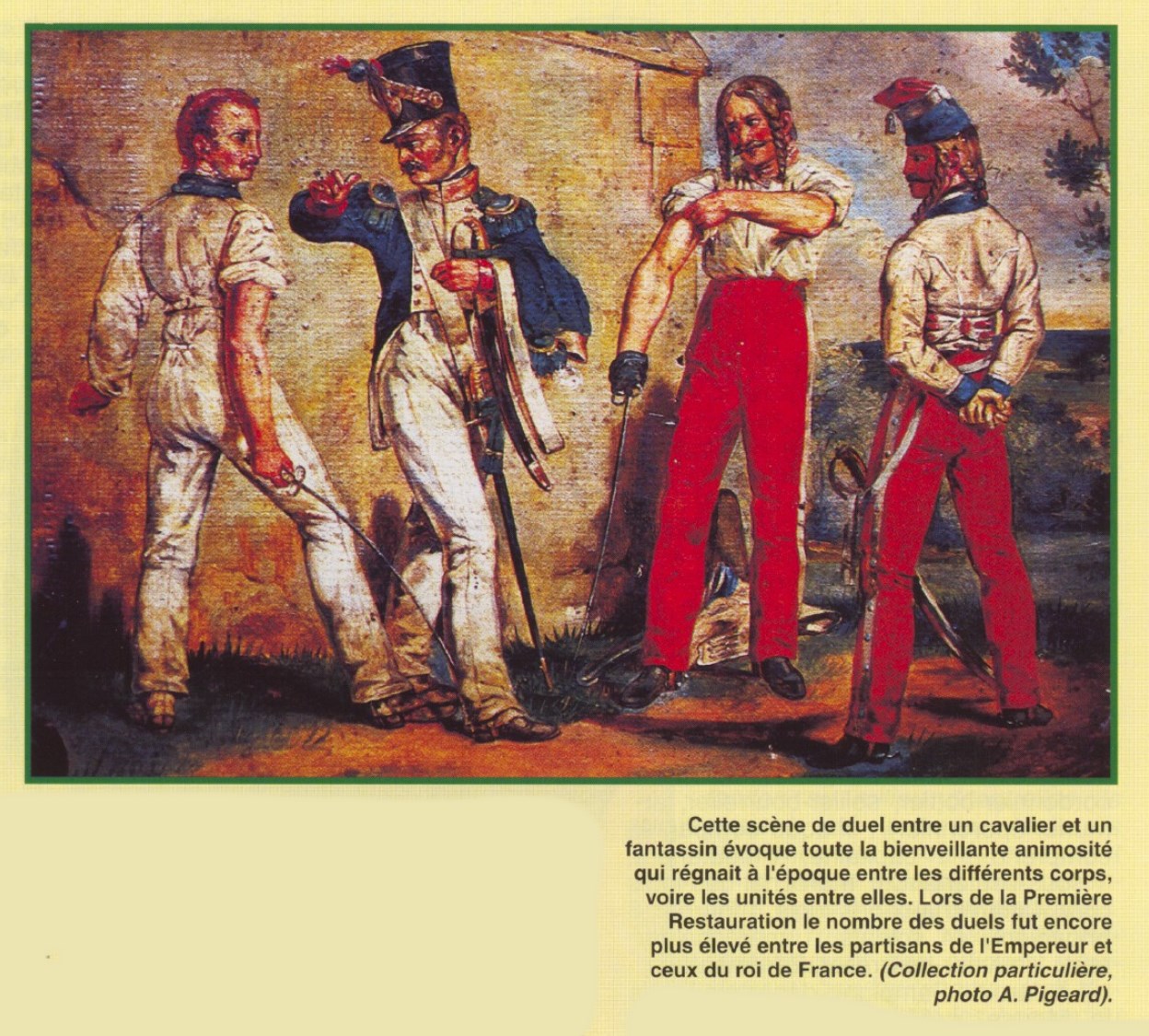
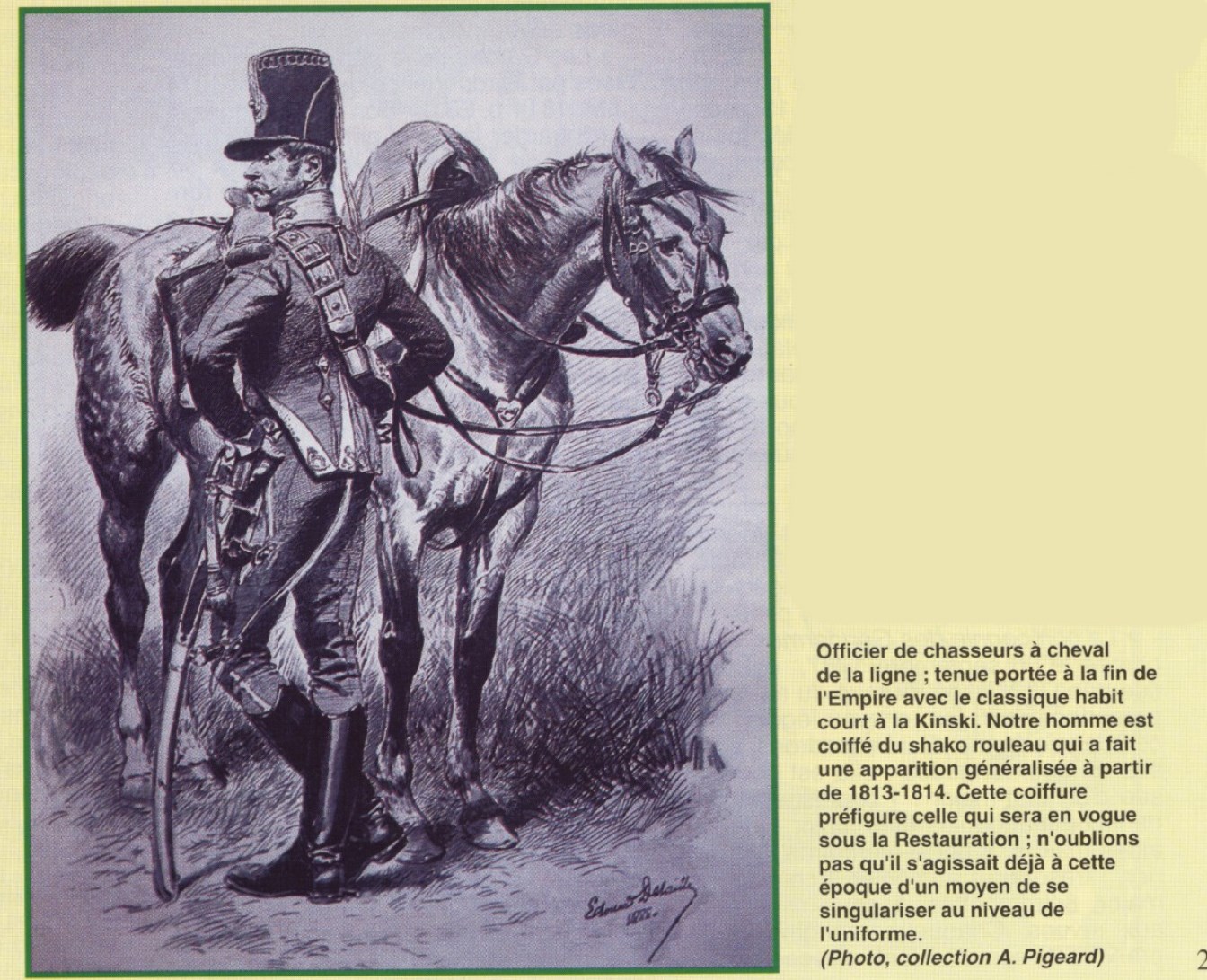
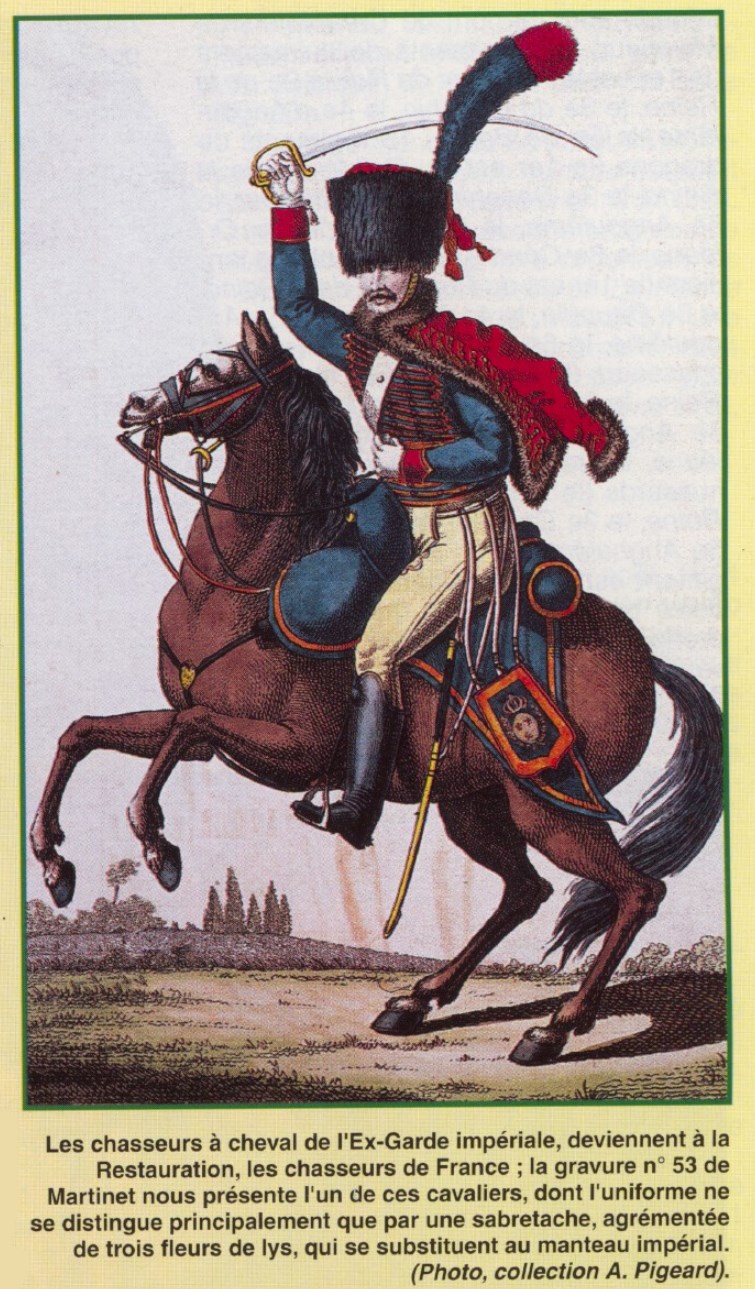
The First Restoration
When the allied armies occupied Paris, they issued a
declaration under the name of the Austrian commander-in-chief, Schwartzenburg,
refusing to deal with Napoleon or any member of his family and inviting the
Senate to form a provisional government. For the first time in public at any
rate, the allies proclaimed the overthrow of the Empire as one of their aims.
This made a restoration of the Bourbons inevitable. There had to be a new
constitution. This was the work of the Senate which contributed five of its
number to the provisional government and twenty members to a constitutional
commission. That is, the body which took responsibility for deposing Napoleon
on 2 April was composed of men from the old revolutionary legislatures, the
dignitaries of the Empire, imperial officials, officers and the like. The
conceptions of government of all these men reflected their backgrounds as
revolutionary and Napoleonic politicians and officials. There would be a
bicameral legislature responsible for consenting to taxes, an independent
judiciary, equality of opportunity, an amnesty for all political opinions,
freedom of religion and the press, fiscal and legal equality, irrevocable
guarantees for owners of biens nationaux, and recognition of both the Old
Regime and imperial nobilities. Although this was changed later, it was even
said that Louis XVIII was `called’ to the throne by `the French people’, in
other words, the nation, not the king, was sovereign. Strangely, many members
of the Senate who drafted this document were from the annexed territories that
were eventually split off from France itself. In a sense, therefore, the
Charter was a European document, imposed upon the French without so much as a
referendum to endorse it. All the other constitutions, except that of 1791, had
been placed before the electorate. It should not be surprising that the
`Charter’ resembled the Constitution of 1791. The self-appointed constitutional
committee liter- ally had a copy available to consult.
If the `men of 1789′ were to triumph, it was essential to
get Louis XVI’s brothers to accept the Charter. In the event, it was forced on
them. When the comte d’Artois arrived in Paris in early April in the uniform of
the National Guard no less, the Senate was extremely reluctant to recognize his
title of lieutenant-general until he accepted the Charter. Tsar Alexander also
insisted that he recognize it. Thus the emergence of a parliamentary regime in
France depended upon a completely unelected body and upon the most despotic of
the European monarchs. With nowhere to turn, Artois conceded. As long ago as
1805, his brother the Pretender had interred the Declaration of Verona which
had promised an integral restoration of the Old Regime. Instead, the Pretender
accepted the existing judicial, military and administrative structure but said
nothing about a legislature with powers over taxation. Another declaration
issued from his English residence at Hartwell on 1 February 1813 reiterated
these points and expressed the hope that the issue of biens nationaux could be
settled by `transactions’ among the present and former owners. Privately, he
disliked the notion of the state paying Protestant ministers.
In the circumstances of 1814 he too would have to bend and,
recognizing reality with none of Artois’s bad grace, he waited until the eve of
his entry to Paris to publish the Declaration of Saint Ouen on 3 May which
accepted the principles of the Senate’s project but not the actual document. A
new commission set to work on a new charter which differed from the old only in
that the Senate was replaced with a Chamber of Peers nominated by the king, the
`senatoreries’ were abolished, and the most restricted franchise of the entire
period was adopted for the Chamber of Deputies. This put electoral power overwhelmingly
in the hands of big landowners. Finally, the preamble to the Charter did not
recognize national sovereignty; instead the Charter was said to be `granted’ by
the king. Thus were planted the seeds of the revolution of 1830.
The fact that the Restoration was effected the way it was
ensured that it would not be counterrevolutionary. None of the elements of
opposition to the Empire the clergy, the malcontents in the army, the
intelligentsia or the royalists of the Chevaliers de la Foi – played- a crucial
role. Nor had the out-and-out reactionaries. In 1790, Artois and the emigres
had planned to effect the counterrevolution by a combination of a military
conspiracy and popular insurrection. Yet in 1814, the officers had remained
loyal almost to the last and many of the troops were Bonapartist. In fact there
had been no great royalist upsurge. Even the royalists of Bordeaux were
probably a minority. At its most optimistic, the little royalist Bordelais army
never numbered more than 800 in a city of 70,000. Elsewhere, violent royalism
was rare. The Chevaliers de la Foi tried to seize Rodez but the leaders called
it off when only 200 `knights’ showed up. There was a royalist riot at
Marseille on 14 April in which Provencal-speaking crowds vainly attacked the prefecture.
This showed that popular royalism still existed but such disturbances were
almost unique. Even the old Vendee militaire and the chouans north of the A
Loire had not risen, an indication of just how effective the imperial
government’s policy of disarming the west had been. Instead, the young men had
responded by trying to avoid conscription, and by the spring there were signs
of a general breakdown of law and order as brigand bands roamed the
countryside. But this was only a pale shadow of the great days of 1793.
There were even pro-Bonapartist demonstrations. Peasants in
Lorraine, goaded beyond endurance by requisition or outright pillage, formed
partisan units. One of them was actually led by a parish priest whose men
showed considerable skill in guerrilla attacks. There are numerous examples of
country people killing allied stragglers or observation troops or picking up
muskets from allied dead on the battlefield and turning them over to imperial
soldiers or coming forward to help troops move heavy cannon through the muddy
roads of Champagne. In mid-April, soldiers stationed in Clermont-Ferrand
countered the prefect’s reading of the de- position decree with cries of `Vive
l’Empereur!’, while a crowd of cavalrymen led by junior officers broke down the
door of the cathedral to harass a priest who had unfurled the white flag of the
Bourbons. In the countryside of Auvergne, there were rumours that a restoration
presaged the re-imposition of the tithe and feudal dues, while later that
summer in a few communes peasants paraded an effigy of the king on an ass. In
Strasbourg, soldiers almost rebelled when they were told to wear the royalist
white cockade. Almost everywhere there was a general refusal to pay taxes, and
in some places there were anti-rscal rebellions. In the Haute-Garonne, Gironde,
Vendee, Seine-Inferieure, Pas-de-Calais and at Marseille, A A Rennes, Cahors,
Chalon-sur-Saone and Limoges, officials of the droits reunis and the octroi
were attacked and their registers burned. Royalist A agents and a proclamation
of the Prince de Conde had led people to believe A that those taxes would be
abolished or much reduced. In some regions like Anjou, people acted on this
propaganda, reasoning that since the war was over no taxes at all were
necessary ± a remarkable example of the survival of medieval notions of fiscality.
When Louis XVIII maintained the droits reunis, disappointment was sharp.
Given time, the restored Bourbons might have been able to
assuage these fears, but from the top down experience soon showed that
reconciling the servants and loyalists of the imperial and royalist regimes
would be far from easy. As major instruments in overthrowing Napoleon, the
senators did exceptionally well. Only 37 of the French senators were excluded
from the 155-member Chamber of Peers, 12 because they were conventionnels,
while 84 were included, each with a magnificent pension of 36,000 francs. To
the end, they had known how to look after themselves. The continuity of
personnel among the upper courts was also great but other institutions suffered
more. Since it was so closely identified with the Emperor, it is not surprising
that 40 per cent of the members of the Council of State were eliminated. There
was no thoroughgoing purge of the prefectoral corps but 28 of 87 were fired
outright because they had been revolutionaries or imperialist zealots, while of
the 36 new appointments which the first Restoration made, one third were former
emigres. The number of nobles in the corps as a whole nearly doubled – a significant
indication of whom the regime thought its friends were. Much of this was to be
expected and the purges were not very great in comparison to those of the
previous twenty-five years, but the voluble courtiers around the comte d’Artois
let it be known that this was only the beginning of a vast settling of
accounts. Intelligent and indolent, Louis XVIII could not muzzle his dim and
impetuous brother.
A careless historiography usually blames the Bourbons
themselves and the utterances of careless ministers for what happened next.
This is far too simple. Whatever gaffes various ministers committed, public
opinion did not turn against the First Restoration overnight. Instead, opinion
remained totally loyal to the Emperor.
In the constitutional scheme of things, the common people
counted for nothing so nothing was done to wean them from the shock of
Napoleon’s defeat. Thus the Emperor retained much of his popularity well after
his abdication. The old Napoleonic bric-a-brac – playing cards, medallions, A
statuettes, broadsheets, dinner plates, and so on – continued to circulate with
the addition of mawkish engravings of the Emperor coming the King of Rome to
the care of the National Guard who supposedly represented the French people.
Enterprising printers put out other drawings depicting a sleeping eagle with
the caption, `He will return!’ Prisoners of war returned with a grudge. Those
who returned from the ghastly hulks of English prison ships were looking for
revenge. Prisoners from Germany, whom the allies had overrun, knew they had not
been defeated. Soldiers like these would welcome a second chance.
Indeed, there were rumours from the beginning of the
Restoration that he already had returned or had escaped to raise an army in
Turkey. The docks in the lower courts were jammed with unfortunate individuals
being prosecuted for having shouted `Vive l’Empereur!’ within earshot of a
gendarme. During the Second Restoration especially, there were many who
predicted that his third coming would be a prelude to the end of days or that
he returned secretly and spoke only to those who really believed or to innocent
children.
Many simply refused to believe the Emperor had gone. Many
believed that somehow Napoleon had been betrayed. Even defeat did not convince
soldiers from Spain who marched through the streets of Grenoble shouting `Vive
l’Empereur! Vive Le Roi de Rome!’
The Second
Restoration
The Bourbon restoration was a time of political instability
with the country constantly on the verge of political violence.
The army was committed to a defense of the Spanish monarchy
in 1824, achieving its aims in six months, but did not fully withdraw until
1828, in contrast to the earlier Napoleonic invasion this expedition was rapid
and successful.
Taking advantage of the weakness of the bey of Algiers
France invaded in 1830 and again rapidly overcame initial resistance, the
French government formally annexed Algeria but it took nearly 45 years to fully
pacify the country. This period of French history saw the creation of the Armée
d’Afrique, which included the French Foreign Legion. The Army was now uniformed
in dark blue coats and red trousers, which it would retain until the First
World War.
The news of the fall of Algiers had barely reached Paris in
1830 when the Bourbon Monarchy was overthrown and replaced by the
constitutional Orleans Monarchy, the mobs proved too much for the troops of the
Maison du Roi and the main body of the French Army, sympathetic to the crowds,
did not become heavily involved.
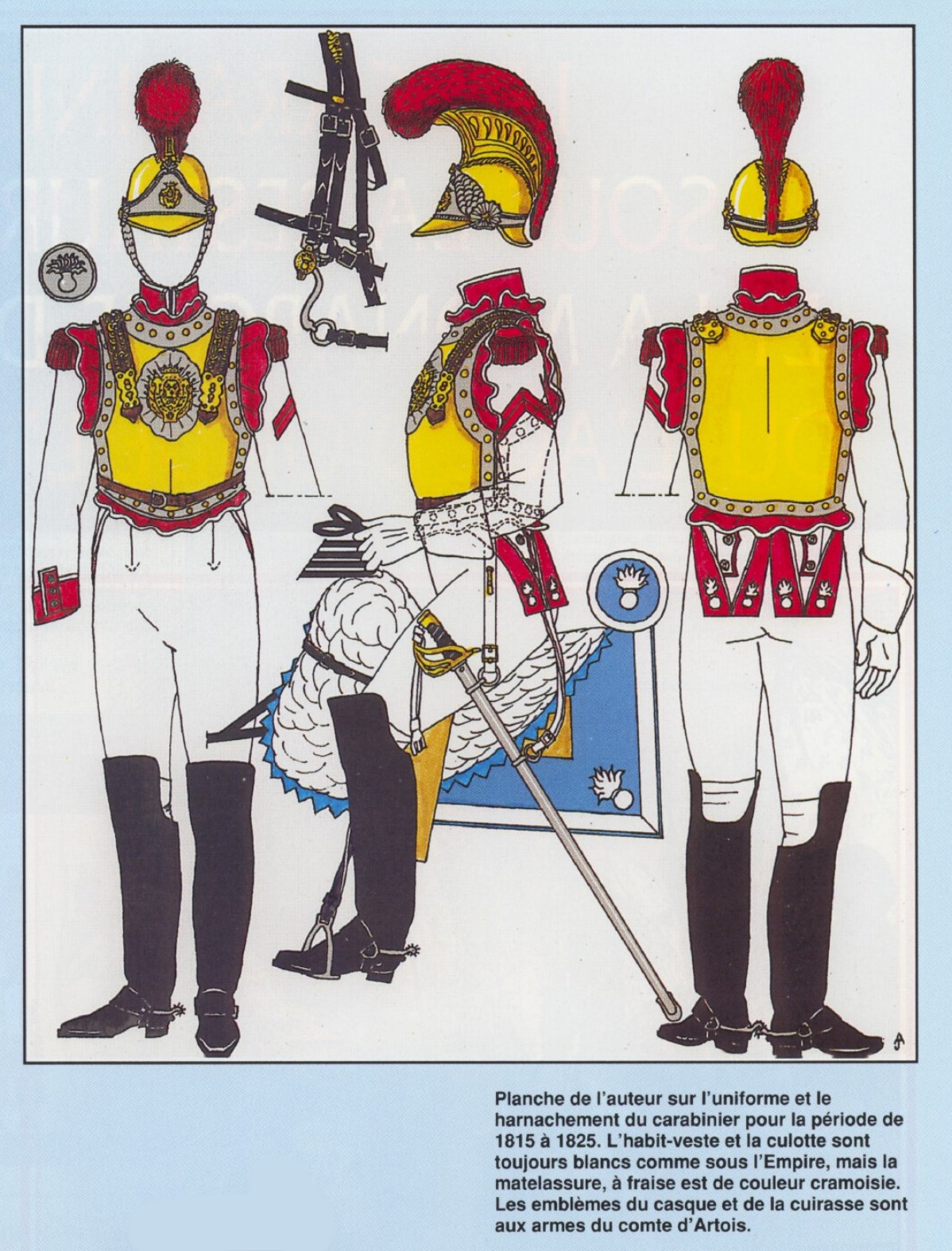
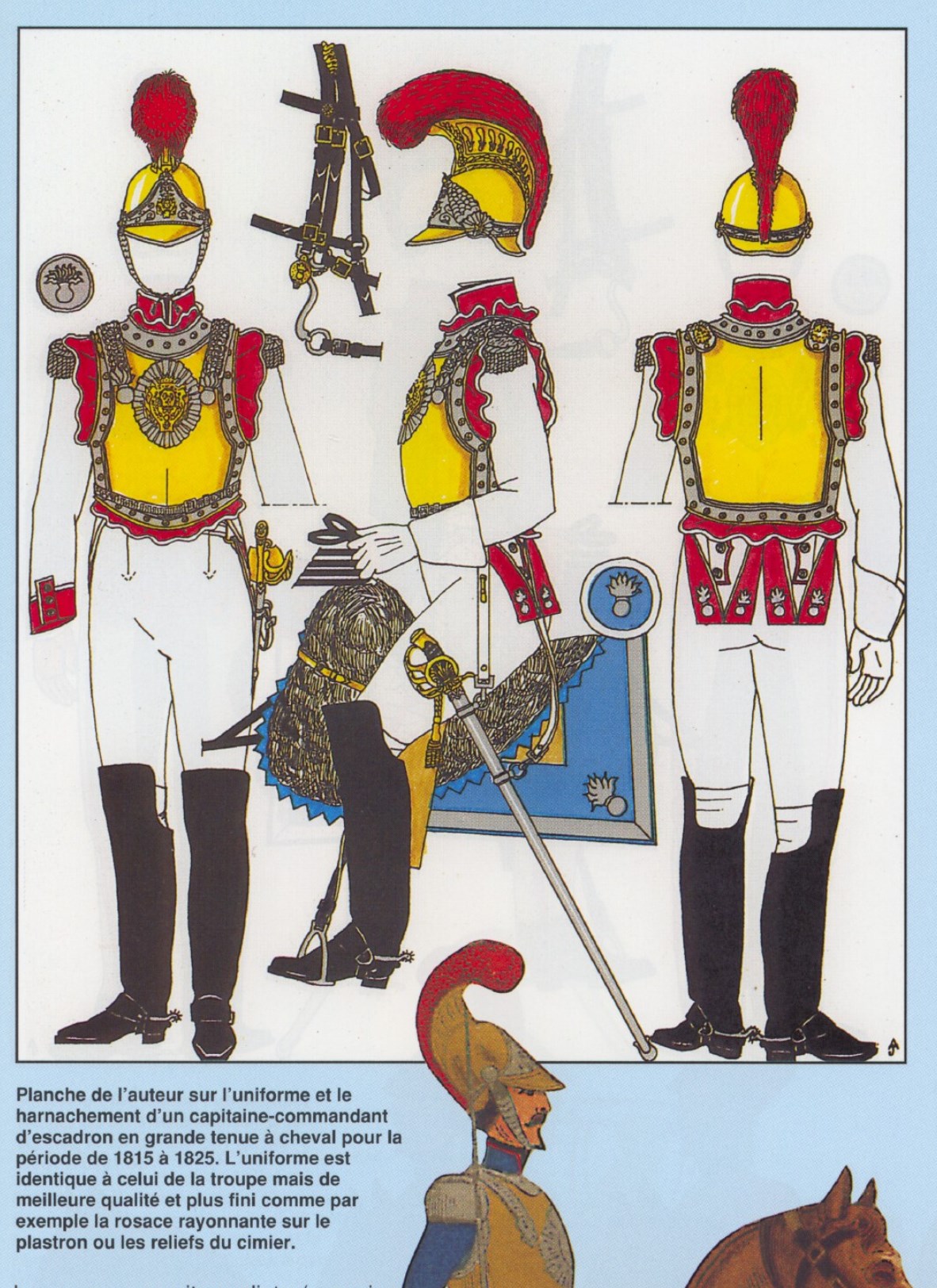
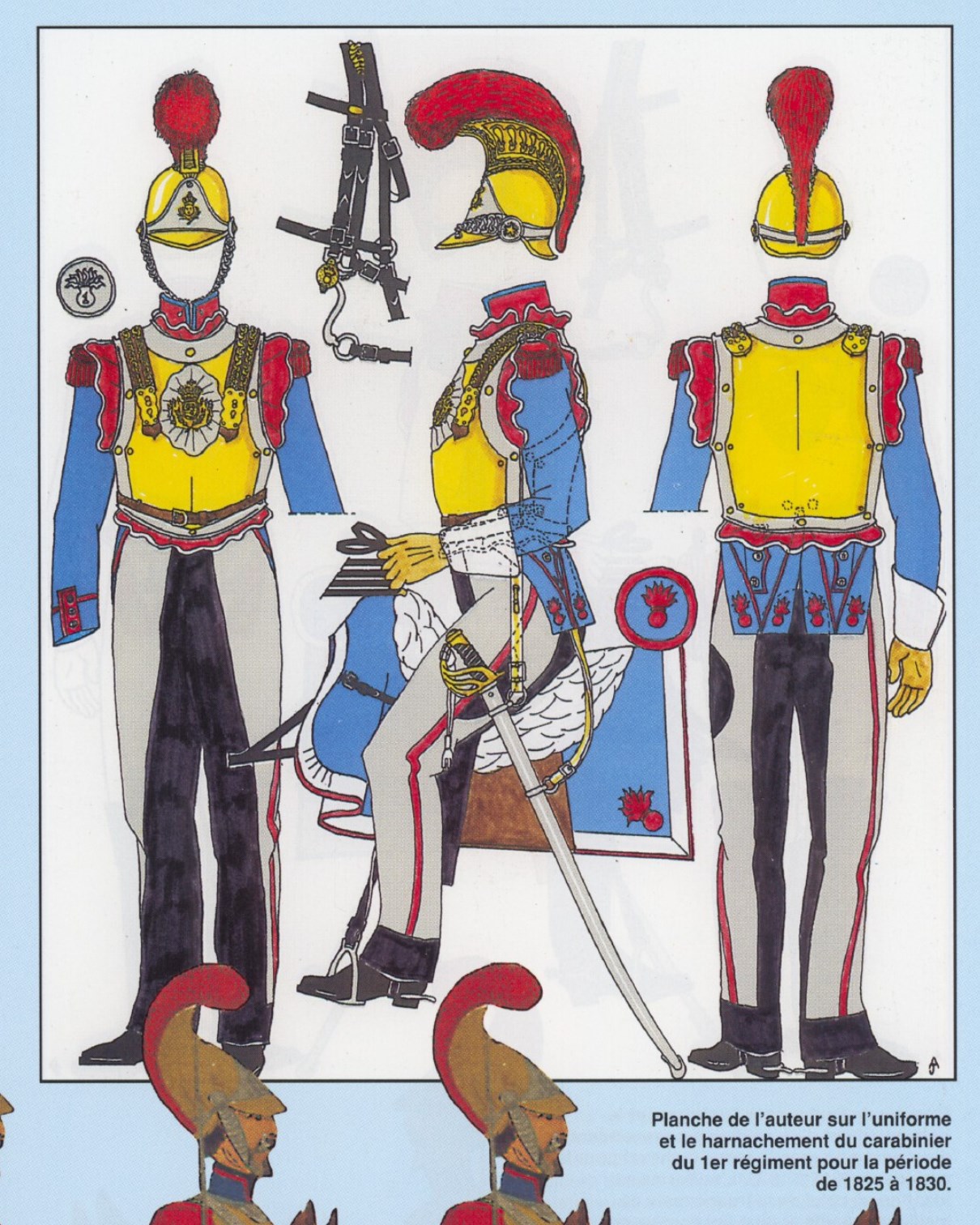
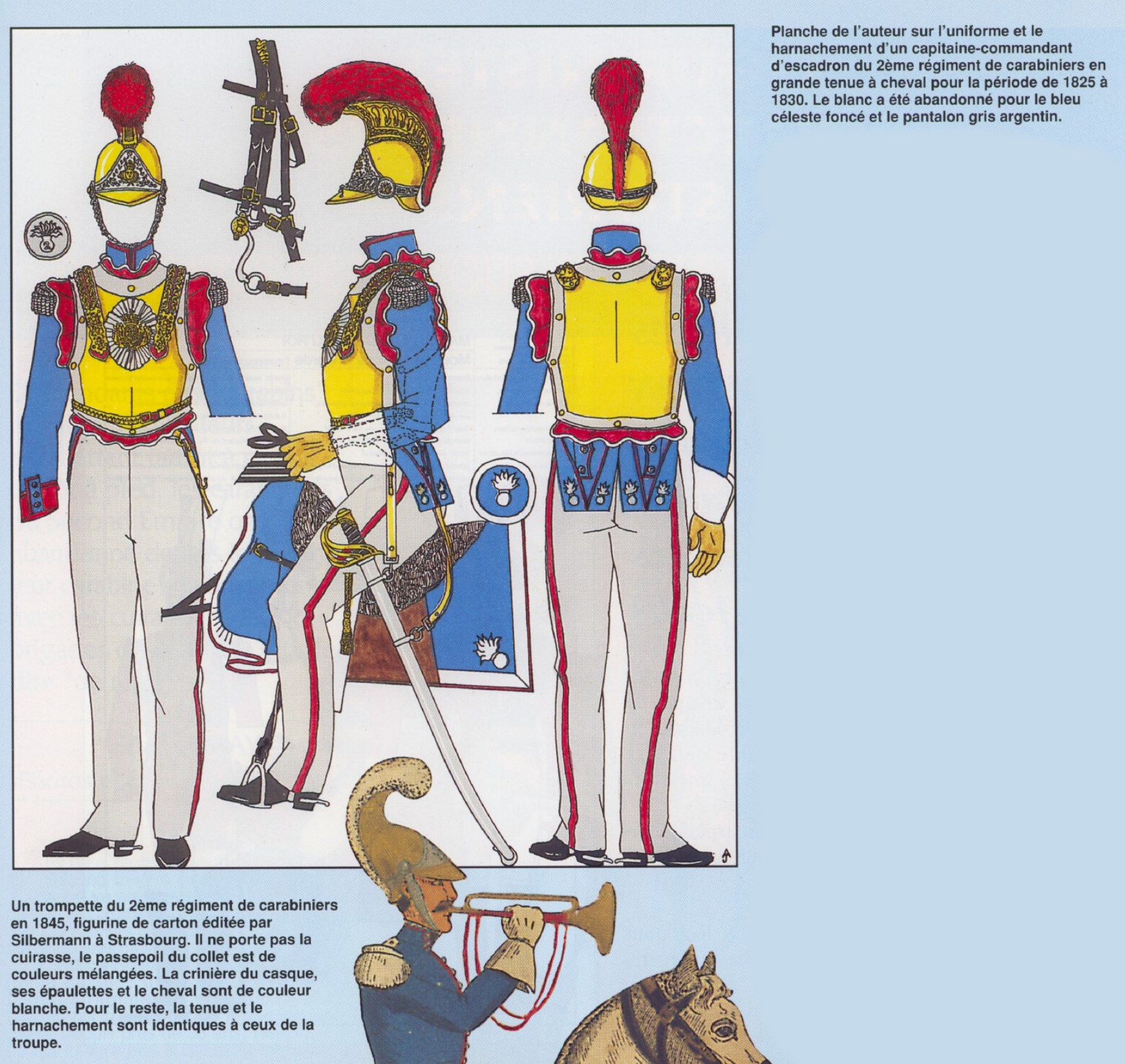
The Royal Army of the
Second Bourbon Restoration
The Blue was reestablished in the Infantry with the
Regiments in 1820 when the Departemental Légions were disbanded, actually these
Légions had only one or two then 2 or 3 Infantry Battalions, a very small
number had really Scouts companies and the Artillery company existed only in
one Légion.
It was an (nearly)all-blue uniform with red collar for all
the régiments and after 1822 various regimental colours for the collar and
cuffs and white trousers for warm weather, so adopted before the first
campaigns outside France since 1815 (Spain in 1823, Greece, Algiers,
Belgium…)
The famous garance trousers were adopted in 1829 under
Charles X even if many people in France think that it was the Monarchy of July
who introduced it.
The 6 Swiss Regiments (2 of the Guard & 4 others)
disbanded in 1830 kept their traditional red uniforms.
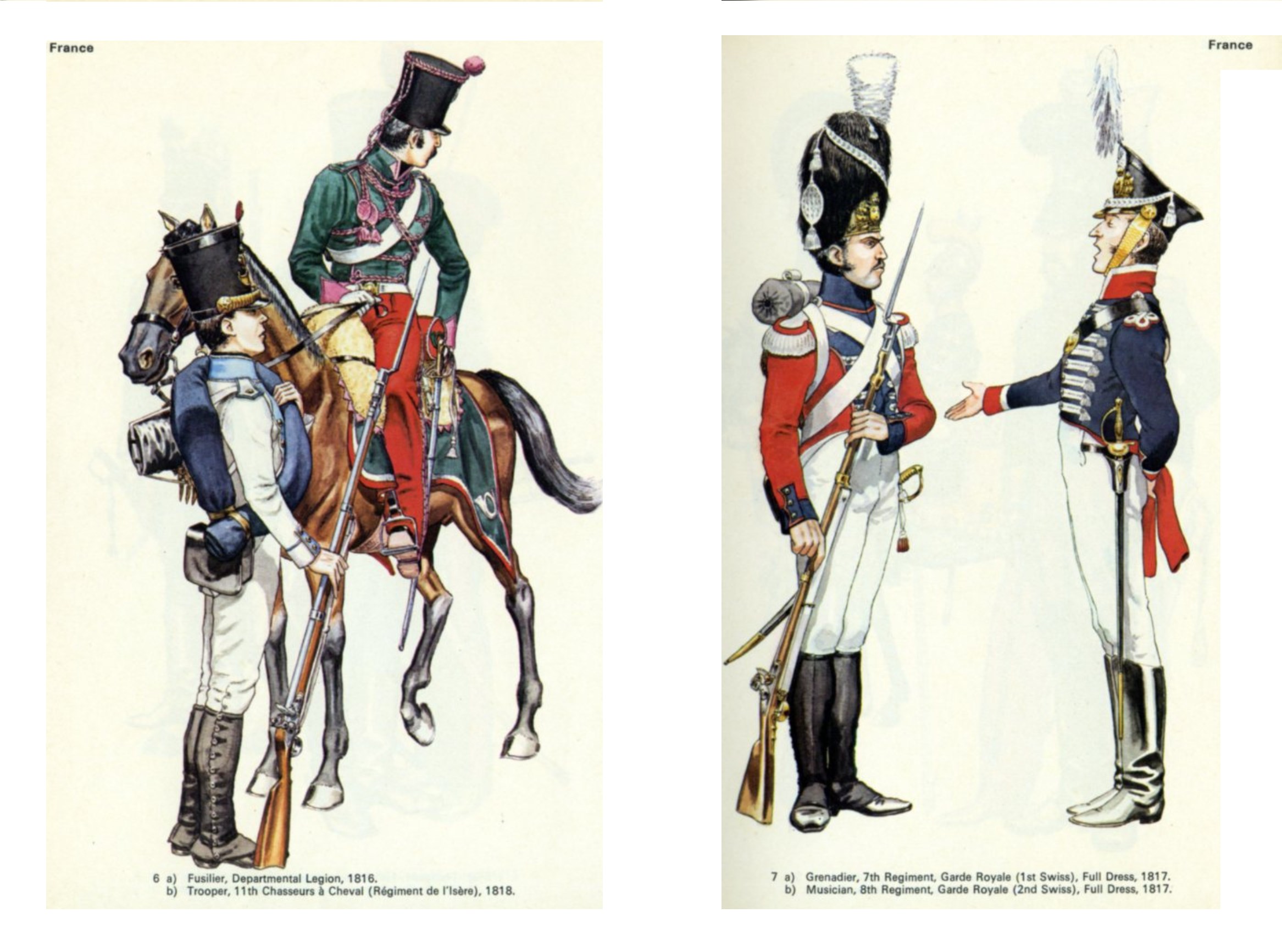
6. France: a) Fusilier, Departmental Legion 1816.
b) Trooper, 11th Chasseurs a Cheval (Régt de l’Isere), 1818.
Details of French infantry uniform changed a number of times
after the Bourbon Restoration, with often considerable delays in the adoption
of new patterns. A Bourbon shako-plate, issued to some units in the middle of
1814, was replaced upon Napoleon’s return by the old Imperial pattern (where
possible), which was itself replaced after Waterloo. After the second
Restoration came more drastic changes – the new Royal Guard continued to wear
blue, but the line regiments were completely reorganised into numbered
‘Departmental Legions’ each of three battalions, wearing a uniform of the 1812
pattern but in white with coloured facings, each of the eighty-six Legions
having a different arrangement of the colouring on collar, lapels and cuffs.
The facing colours were, for the 1st to 10th royal blue; 11th-20th yellow, 21st-30th
red, 31st-40th deep pink, 41st-50th carmine, 51st-60th orange, 61st-70th light
blue, 71st-80th dark green, and 81st-86th violet. The jacket turnbacks and
shako-plumes distinguished the various companies, fusiliers having
turnback-badges of the fleur-de-lys, voltigeurs of hunting- horn, chasseurs of
hunting-horn and fleur-de-lys, and grenadiers of the traditional bursting
grenade. Initially, the 1812 shako was worn with the 1814 Bourbon plate, but in
March 1816 a narrower-topped shako was introduced, and in 1818 metal instead of
white cloth cockades were adopted. A padded cloth disc was worn on fusilier
shakos, of blue for the 1st battalion, red for the and, and green for the 3rd
(until 1819 when extra battalions were added; then the 3rd took yellow discs
and the 4th green) with a brass company numeral on the disc. Grenadiers and
voltigeurs had pompoms of red and yellow respectively.
Chasseur a Cheval uniform changed considerably over the
years, these light cavalry troops in 1816 wearing lapelled jackets, having
Hussar-style braid by 1822 and becoming single- breasted in 1831. The tall,
cylindrical shakos had black plumes tipped with the facing colour, later
changed to falling black plumes, though pom- poms were also worn alone; in 1845
the busby was adopted at the same time as the red epaulettes (worn since 1831)
were changed to white.
Under the Bourbons, regiments again assumed titles as well
as numbers. Chasseur a Cheval regiments were organised in groups of three, the
first in the group having both collar and collar-piping in the facing colour,
the second with green collar and coloured piping, and the third with coloured
collar and green piping. In 1818 regimental names and facing colours were:

In 1822 this scheme changed, with regiments being grouped in
fours, the first two in each group having coloured collars with green piping,
and the last two in each group having green collars with coloured piping.
Facing colours at this time were: Ist-4th red 5th-8th yellow, 9th-12th carmine,
13th-16th blue, 17th-20th deep pink, 21st-24th orange.
An interesting feature of the uniform illustrated-taken from
a contemporary print by Canu is the elaborate method of wearing the
shako-cords.
7. France: a) Grenadier, 7th Regt, Garde Royale (1st Swiss),
Full Dress, 1817
b) Musician, 8th Regt, Garde Royale (and Swiss), Full Dress,
1817.
It was traditional for the French Royal Guard to include
Swiss units, these troops being ranked among the King’s closest bodyguard prior
to the Revolution. Upon the first Restoration, a company of Cent-Suisses was
established, but not revived after the Waterloo campaign. Instead, of the eight
Guard infantry regiments raised upon the second Restoration, the 7th and 8th
were composed of Swiss and alternatively titled the 1st and 2nd Swiss
Regiments. Unlike the other six regiments (which wore blue uniforms) the Swiss
units continued to wear their traditional scarlet uniform, a colouring which
had been used during the Ancien Régime and by Napoleon’s Swiss corps; whereas
the grenadiers of the other Royal Guard regiments wore red epaulettes
(voltigeurs orange, centre companies white and chasseurs green), to prevent a
clash of colour between jacket and epaulettes the grenadiers of the Swiss
regiments continued to wear the white epaulettes of Napoleon’s day. All Royal
Guard infantry wore the lace loops on the breast; the fur cap was reserved for
grenadiers, the remainder wearing shakos.
Musicians (in every army) were traditionally distinguished
by unusual costume, the most frequent variation being that the body of the
uniform was of a different colour to that of the remainder of the regiment. The
uniform illustrated is no exception, being in the classic ‘reversed colours’
style (i. e. the body of the coat in the regimental facing colour and the
collar and cuffs in the usual coat-colour). An interesting feature of this
uniform is the shako, being reminiscent of the Russian ‘kiwer’ pattern, but of
a greater height. Shako-plates for musicians were frequently of a more
elaborate form than those of the remainder, in this case being a representation
of the Royal Arms with a trophy of flags around. The ‘trefoil epaulettes were a
common musicians’ distinction, dating from the Napoleonic period.
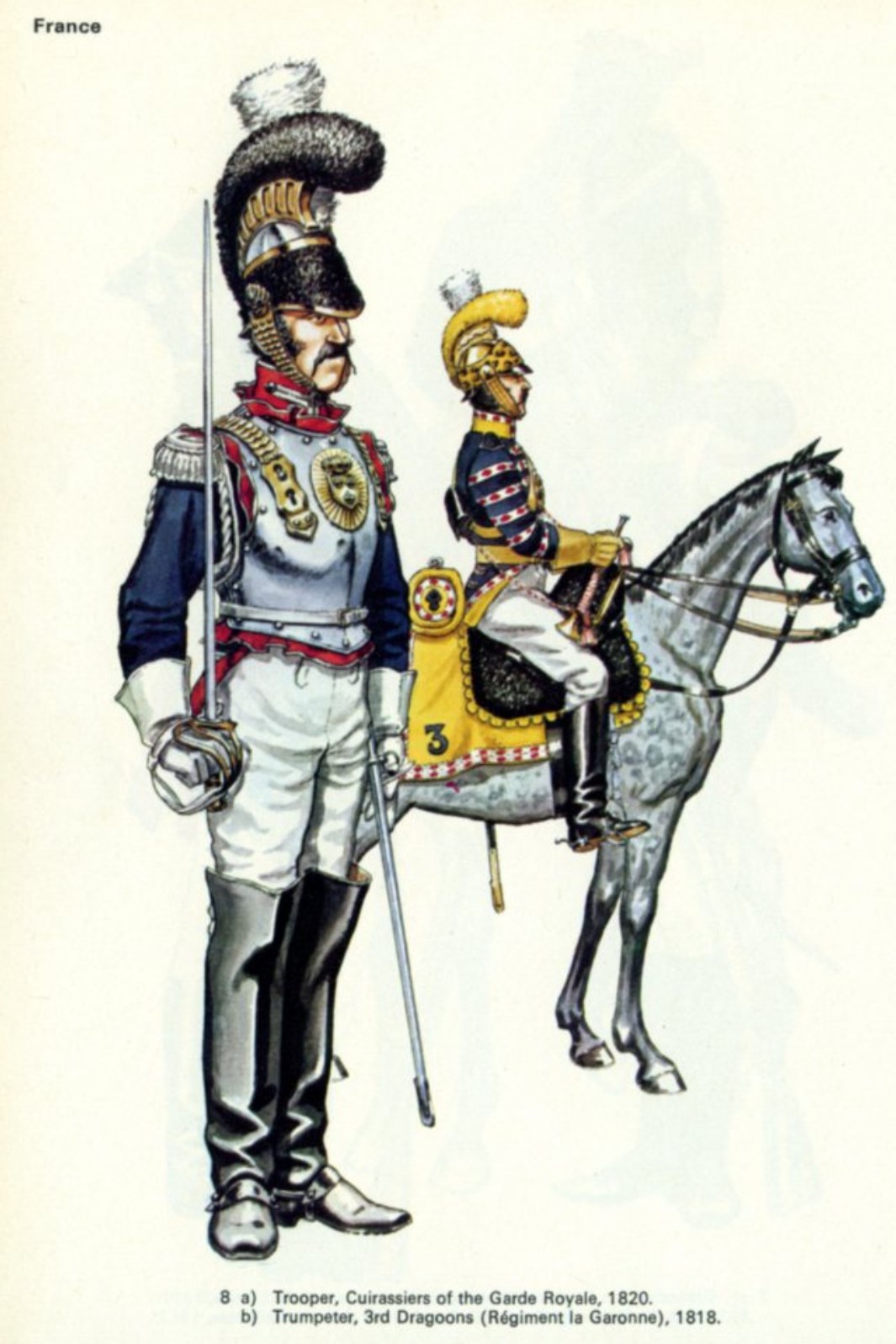
8. France: a) Trooper, Cuirassiers of the Garde Royale,
1820.
b) Trumpeter, 3rd Dragoons, (Régt La Garonne), 1818.
In 1815 a new helmet with caterpillar crest was adopted by
the French Dragoons, but was replaced by a pattern with horsehair mane authorised
in July 1821; but it seems likely that in some cases it was as late as 1825
before the new pattern was issued. The green uniform-colour associated with the
Napoleonic period was retained, regiments being allotted names and
facing-colours in a similar style to that of the Chasseurs a Cheval, described
in Plate 6. Names, numbers and facing-colours were as shown in the chart.

The uniform illustrated, however, shows an interesting
variation; an ornate trumpeter’s uniform with yellow helmet-crest (instead of
the usual black), and a blue uniform bearing regimental facings but with the
musicians’ lace of white with interwoven crimson ovals. The facing-colour was
also borne on the shabraque.
Though Napoleon’s Imperial Guard had included no
cuirassiers, the Bourbon Royal Guard did; two regiments, wearing almost
identical uniforms, strongly reminiscent of the cuirassiers of the Empire. The
helmets were of the old pattern, but with the horsehair mane replaced by a
cater- pillar plume, and the cuirass emblazoned with the Royal arms. Otherwise,
the costume might have belonged to a regiment of Napoleon’s. Both regiments had
white helmet- plumes, but the and had a red ball-tuft at the base. These
helmets were replaced in 1826 by a pattern lacking the skin turban, though the
and Regiment did not receive theirs until 1827
Other Guard cavalry regiments also wore uniforms based upon
those of their Imperial predecessors the Dragoons had brass helmets with
leopard-skin turbans, caterpillar crests and white plumes, green coatees with
rose-pink facings; the Horse Grenadiers had fur caps with white plumes for the 1st
Regiment and red-and- white for the 2nd, dark blue coats with white lace bars
on the breast, with red facings for the 2nd Regiment; and the Garde du Corps a
helmet similar to that of the old Gendarmes, with a red-faced blue uniform, each
company being distinguished in a singular manner, by coloured squares on the
pouch-belt. The first four companies to be raised had white, green, blue and
yellow belts respectively, and the 5th (when formed) scarlet.
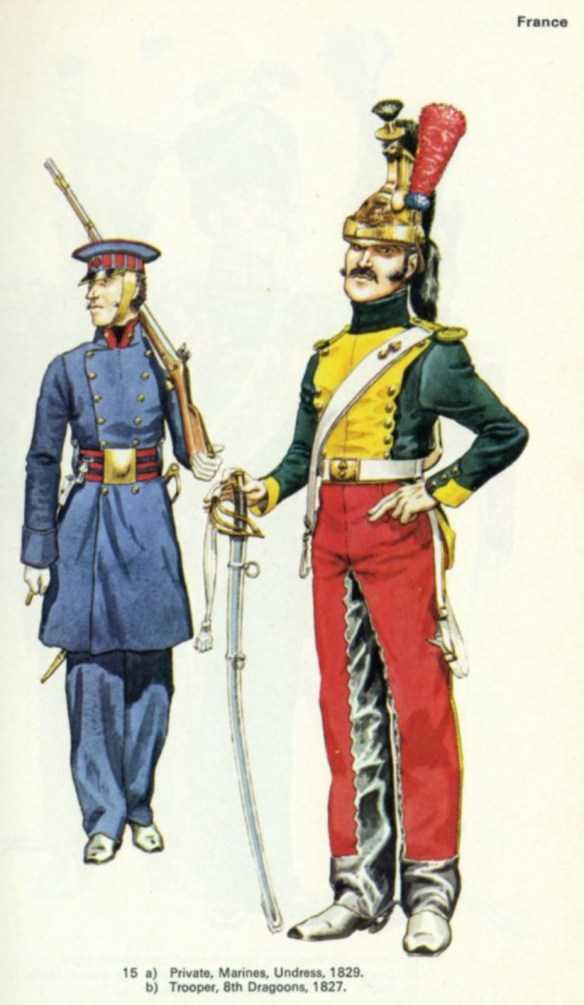
15. France: a) Private, Marines, Undress, 1829.
b) Trooper, 8th Dragoons, 1827.
This plate illustrates the Dragoon helmet (also issued in
steel to the cuirassiers) which was authorised in 1821 but in some cases
probably not adopted until 1825, succeeding that shown in Plate 8. Of a most
unusual pattern, of the traditional Dragoon brass, it had a horsehair mane and
aigrette, and a hair ‘brush’ along the top of the crest. In 1826 squadron-identification
in the form of a coloured ball placed at the bottom of the plume was added, in
blue for the 1st squadron of every regiment, crimson for the 2nd, green for the
3rd, sky-blue for the 4th, rose-pink for the 5th and yellow for the 6th. This
helmet lasted until 1840, when it was replaced by a more conventional pattern
with ordinary mane and leopard-skin turban. The jackets remained the
traditional dragoon green in colour, but by 1823 new facing-colours had been
introduced, of deep rose for the 1st-4th Regiments 5th-8th yellow, and crimson
for the 3th and 10th. Trousers were grey with piping of the facing colour,
later changed to plain red for dismounted wear and red with leather reinforcing
for mounted duty, but it appears that there were variations in this rule; the
print from which this plate is taken shows red trousers with piping of the
facing colour!
The French Marines- organised in five divisions in May 1829-
wore a most singular uniform in both full and undress. The full-dress helmet
was an odd-shaped item, with a spherical black leather skull and brim like a
bowler, with a narrow brass crest supporting a black woollen crest, a brass
front plate and brass bosses on the side, embossed with fleur-de-lys motif, and
brass chinscales. The full-dress jacket was short, of dark blue with brass
buttons and shoulder- scales, worn with plain blue trousers black gaiters and
the same girdle as worn in undress. The undress uniform (chiefly remarkable for
the striped cap-band and chinscales) was worn with the same equipment as full
dress, having a black leather cartridge- box with brass anchor badge worn at
the rear of the girdle, in the middle of the back. Bayonet and brass-hilted
sword were worn in both orders of dress. The Divisions of Brest, Toulon and
(until 1832) Rochefort each maintained a band, the first two of great repute;
the drum-majors’ uniform included plumed busby, sash, mace, and a special
pattern of sabre The full dress helmet was abolished for wear at sea in 1832,
but remained in use for shore duty until 1840.
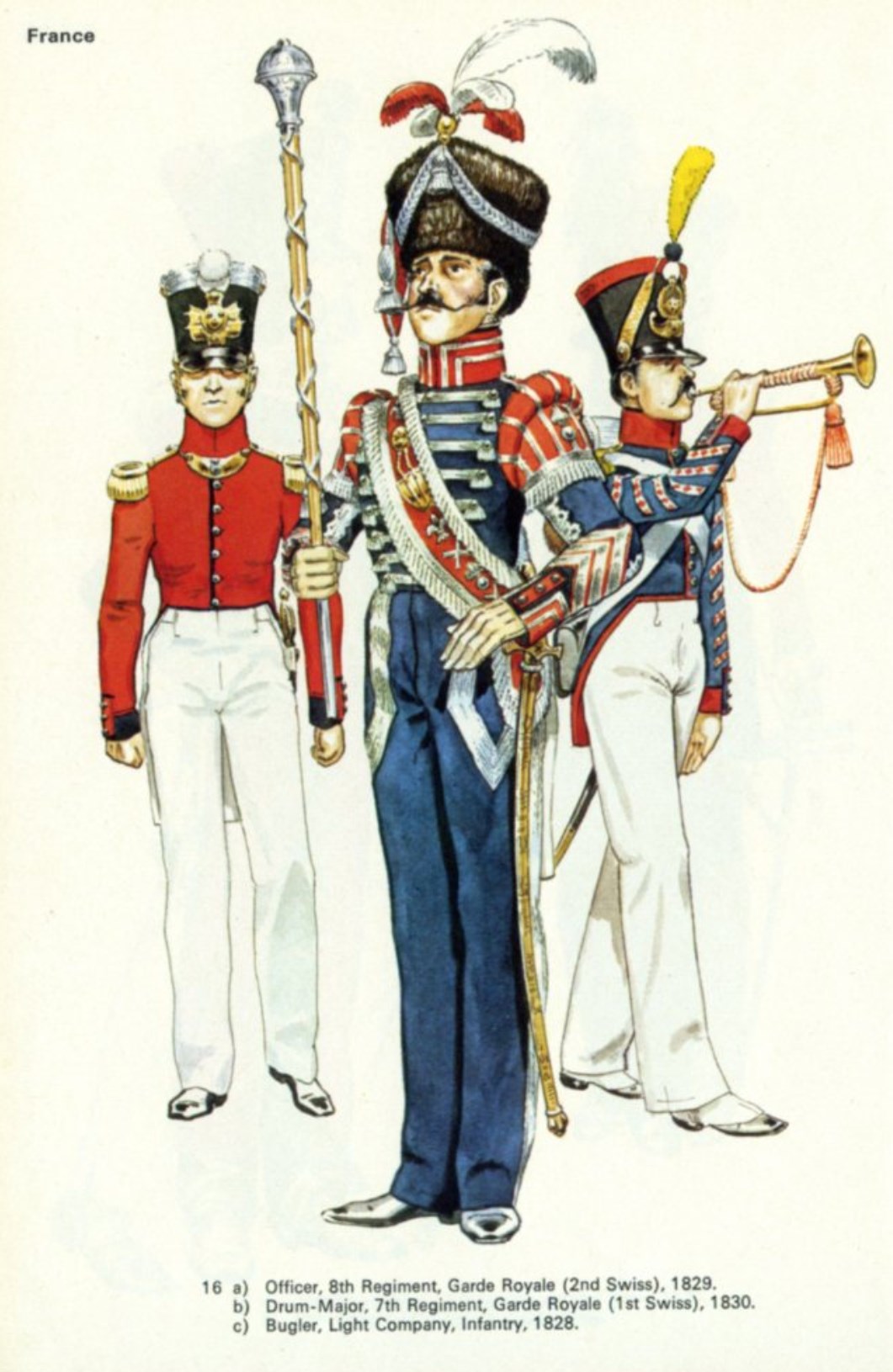
16. France a) Officer, 8th Regt, Garde Royale (and Swiss),
1829.
b) Drum-Major, 7th Regt, Garde Royale (1st Swiss), 1830
c) Bugler, Light Company, Infantry, 1828.
The Departmental Legions (Plate 6) were replaced in 1822 by
numbered infantry regiments in the previous manner, wearing single-breasted
dark blue jackets, white trousers for summer and blue for winter, and red
epaulettes for grenadiers, yellow for voltigeurs, and shoulder-straps for
fusiliers. In May 1822 facing colours were allocated to all 6o regiments, a
different combination of collar, cuffs, piping and turnbacks identifying the
individual corps. These colours were white for regiments 1-4, 5-8 crimson, 9-12
yellow, 13-16 rose-pink, 17-20 orange, 21-24 light blue, 25-28 buff, and 29-32
green, the colour-sequence repeating from the 33rd to 60th; regiments 61 to 64
were raised in February 1823. Another new shako- plate was introduced in 1821,
and a new shako n 1825, which had grenadiers and voltigeurs distinguished by
double pompoms of red and yellow respectively. In 1828 facing-colours were
abolished, all line regiments taking red facings, and light infantry yellow.
Musicians as usual disregarded the official regulations as
shown by the bugler in this plate; in 1827 the lace chevrons on the arms were
abolished, but are worn, though the authorised collar-and cuff-lace is not
musicians of fusilier companies often wore the epaulettes and plumes officially
reserved for flank companies while in many cases drum-majors still wore the fur
busby.
The two Swiss regiments of the Garde Royale illustrated show
the progression in costume from those shown in Plate 7. The musicians wore
reversed colours of blue with red facings, the bandsmen (though not drummers
and fifers attached to companies who wore the appropriate shako or grenadier
cap) having busbies; the jackets, now single- breasted, retained the bars of
lace on the breast. The drum major’s uniform illustrated was typical of the
opulent, lace-covered dress traditionally associated with French musicians.
Other Royal Guard infantry units adopted the
infantry-pattern jacket in 1822, retaining their distinctive lace and
grenadiers their bearskin caps, The 1st, 2nd and 3rd Regiments had cuffs and
turnbacks of crimson, rose- pink and yellow respectively, the 4th 5th and 6th
having the same facing-colour sequence but with blue cuffs, the facing colour
showing on the cuff- flaps and turnbacks only. Epaulettes were white for all
regiments, as were the shako- and grenadier cap-cords.
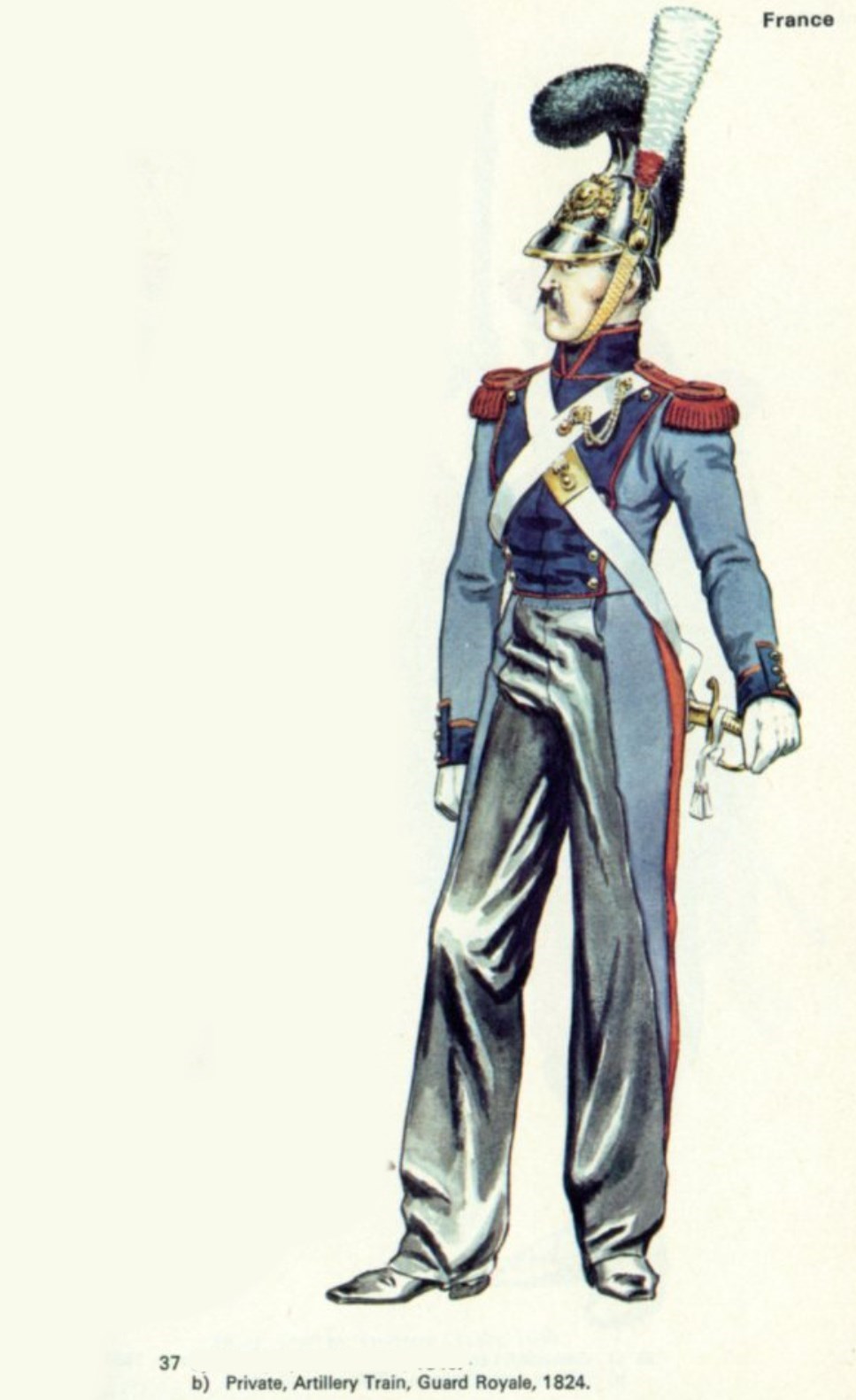
37 France: b) Private, Artillery Train, Garde Royale, 1824.
The uniform of the Artillery Train of the Royal Guard
illustrated is strongly reminiscent (in colouring) of its equivalent in Napoleon’s
army. The helmet, bearing the Royal arms on the front, was a development of the
style adopted immediately after Waterloo, being similar to the 1792 fur-crested
helmet originally copied from the British Tarleton.
Allied Occupation of France: 1815‒18 and the Royalist French Army is Rebuilt
Revolt in Spain
In January 1820, a liberal revolt led by Spanish troops
under General Rafael del Riego compelled absolutist King Ferdinand VII to
implement the Spanish constitution of 1812. That constitution – full of goodies
like universal suffrage (at least for men) and freedom of the press – had been
drafted by the Spanish national assembly (the Cortes) when they were trying to
rid the country of King Joseph Bonaparte and Napoleon’s troops during the
Peninsular War. Upon the constitution’s resurrection, Ferdinand became a de
facto prisoner of the Cortes. He retired to Aranjuez, south of Madrid. When a
counter-revolt by extreme royalists in July 1822 failed to liberate him,
Ferdinand called on the other European monarchs to come to his assistance.
The issue was taken up at the Congress of Verona in late
1822. The Holy Alliance (Russia, Prussia and Austria) was concerned about the
threat posed by revolutionary movements such as that in Spain, and Russian Tsar
Alexander I was keen to intervene. The British – represented at the Congress by
the Duke of Wellington – were opposed to intervention. Austrian Foreign
Minister Clemens von Metternich was in favour of restoring legitimate monarchs,
but did not want to give Russia an excuse to extend its power.
France was in an awkward position. As Ferdinand VII was a
member of the House of Bourbon, French ultra-royalists were pressuring King
Louis XVIII to rescue his distant cousin. Louis, however, disapproved of
Ferdinand’s brand of absolutism, and neither he nor Prime Minister Joseph
Villèle favoured sending troops into Spain. War would be expensive, the army
was not well organized, and the loyalty of the troops was questionable. As a
compromise, the government had already deployed soldiers along the border with Spain,
ostensibly to prevent the spread of yellow fever into France. This “cordon
sanitaire” became an observation corps.
France’s representative at the Congress of Verona, Foreign
Minister Mathieu de Montmorency, was on the side of the ultra-royalists. He
ignored Villèle’s instructions to limit discussion of the Spanish question.
Arguing that turmoil in Spain posed a threat to all of Europe, and especially
to France, Montmorency told the Congress that circumstances might force France
to recall her ambassador from Madrid, leading the Spanish Cortes to declare war
on France. He then asked whether, if France were compelled to engage in a
defensive war with Spain, she could count on the support of her allies. Russia,
Austria and Prussia agreed to provide moral and possibly material support.
Britain would not provide support. Instead, she offered to mediate between
France and Spain. The offer was refused. Amidst much hand-wringing over the
assault on Spanish liberty, Britain ultimately adopted a position of neutrality.
Though the way was paved for unilateral French intervention
in Spain, Villèle – backed by Louis XVIII – refused to go along with the plan.
Montmorency resigned. His replacement, François-René de Chateaubriand, also
favoured intervention, arguing that it would give France an opportunity to
regain great power status. There were fierce debates in the Chamber of
Deputies. Ultra-royalist pressure forced Villèle and the king to give in. On
January 28, 1823, Louis XVIII told the Chambers:
I have done every thing to ensure the
security of my subjects, and to preserve Spain from the extreme of misfortune.
The blindness with which the propositions, sent to Madrid, have been rejected,
leaves little hope of peace.
I have ordered the recall of my minister,
and one hundred thousand Frenchmen, commanded by a prince of my family, are
about to march and invoke the God of Saint Louis to preserve the throne of
Spain for a descendant of Henri IV, to save that fine kingdom from ruin, and to
reconcile her to Europe.
The Army of the Pyrenees, mobilized for the invasion –
actually numbered around 60,000. The problem of ensuring soldiers’ loyalty
without compromising their efficiency was dealt with by giving primary commands
to former Napoleonic generals (who had the necessary experience) and secondary
commands to royalists (who were unlikely to mutiny). Louis XVIII’s nephew, the
Duke of Angoulême was made commander-in-chief, despite his lack of military
experience. He was not keen on the appointment, but agreed to it as an
honourary post, leaving the army’s actual military direction to General Armand
Guilleminot, who had served under Napoleon.
The government hoped that victory over the revolutionary
forces in Spain would break the spirit of those who were conspiring against the
Bourbons in France. Many French political refugees, including some who had fled
to the United States and participated in the Vine and Olive Colony or the Champ
d’Asile, fought on the side of the Spanish constitutionalists. Among them was
the indomitable Charles Lallemand, who organized a Legion of French Refugees in
Spain.
At the beginning of February 1823, police spies reported
they had heard that:
Before the end of the month, Spain will
have organized an army of one hundred and eighty thousand men to oppose the
French invasion; this army will have for its vanguard a French legion, which
will march under tri-coloured flags; this legion will nominate a French regency
with Prince Eugène Beauharnais at its head….
The French army will be the scorn of all
Europe; it can hope for no success when commanded by a prince…who has no claim
on the confidence of true Frenchmen….
The first shot fired at the Pyrenees shall
be the signal for the downfall of the Bourbons in France, Spain and Naples.
Such are the hopes and prayers of the liberals in all countries.
On April 6, 1823, the question of the army’s allegiance was
answered. A group of insurgents led by Colonel Charles Fabvier tried to subvert
the French forces at the Bidassoa River who were preparing to enter Spain.
Fabvier’s group hoisted the tricolour flag, sang “La Marseillaise” and urged
the soldiers to desert the Bourbons. Instead the French troops obeyed General
Louis Vallin’s orders to open fire on Fabvier and his men.
The war
The next day, the French army entered Spain. They met little
resistance. As an Irish visitor to the country reported:
The Constitution, no matter what may be its
excellence or imperfection, has certainly not succeeded in gathering around it
the sentiments and good wishes of a majority of the people of that country. …
[A]pathy, to use the mildest expression, prevailed in all the towns through
which we passed after leaving Madrid. From my own observations, and those of
others, I can safely state that the great majority of the people on the line of
that route desired nothing so much as peace. They have been vexed and injured
by repeated contributions and conscriptions, and latterly, by anticipations of
the current year’s taxes, their means of complying with them being extremely
limited. … However ardent may be an Englishman’s wish that Spain may enjoy
liberal institutions (and if he were without a wish of this nature he would be
undeserving of his country); still, when he saw that the idea of civil liberty
was carried in that nation to an extreme which promised no durability, and that
this extreme, supported only by bayonets and by official employes, was the
inviolable system which England was called upon to assist with her mighty arm,
he cannot but rejoice that that assistance was refused, and that the strength
of his country was reserved for more worthy purposes. …
In the villages where I had occasion to
stop, I encountered no person who did not, at least, say that he was glad that
the French had entered Spain. The poor people I heard it more than once
observed, never liked the Constitution, because they never gained any thing by
it. Since it was established, they had known no peace, and they liked the
French, because they paid them well for every thing they consumed. It was also
observed, that since the establishment of the Constitution, this part of the
country was overrun with robbers; but that all that was now over, as the
robbers had disappeared since the French came.
The French soon controlled Navarre, the Asturias and
Galicia. Andalusia, the site of Cádiz (the constitutionalists’ provisional
capital, to which they had carried Ferdinand), took longer to subdue. On August
31, in the only significant battle of the campaign, the French took the
fortress of Trocadero and turned its powerful guns toward Cádiz. The city
surrendered on September 30. The Cortes dissolved itself and released Ferdinand
VII, who rejected the 1812 constitution, restored absolute monarchy and took
revenge on his opponents. In November, the Duke of Angoulême returned to
France, leaving behind an occupying force of 45,000. The last French soldiers
were not withdrawn until 1828.
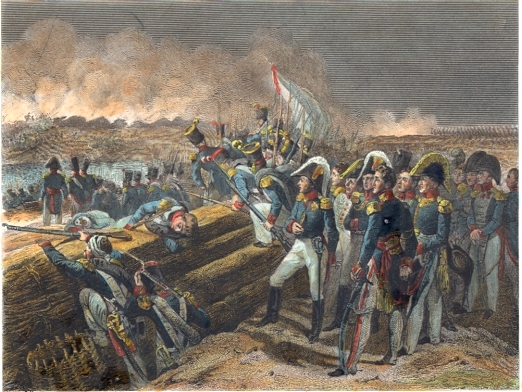
French assault on Fort Trocadero
The expedition was considered a great triumph for the
Restoration. Chateaubriand wrote:
When I entered upon the foreign department,
legitimacy was about, for the first time, to launch its thunders under the
drapeau blanc, to strike its first coup de canon after those coups de l’empire,
which will resound to the latest posterity. If she recoiled, she was lost: if
crowned with mediocre success, she became ridiculous. But at one step to stride
over the Spains – to succeed where Bonaparte had been baffled – to triumph upon
that very soil whereon his armies had met with reverse – to do in six months
what he could not do in seven years – here is a true prodigy!
Villèle exploited the rush of grateful patriotism by
appointing a new batch of ultra-royalist peers and calling a general election
for early 1824. The left and centre were decimated, giving the ultra-royalists
a clear majority.
Louis XVIII, King
(1755-1824)
When Bonaparte seized power in 1799, royalists hoped he
would pave the way for a restoration of the Bourbon dynasty, in the person of
the pretender Louis XVIII. In the event, this younger brother of the
unfortunate Louis XVI would only succeed to the throne in 1814, after
Napoleon’s first abdication. By the time of his belated accession, contrary to
the famous jibe that he lived in the past, Louis XVIII had finally learned a
little and forgotten something of the old regime. His recent sojourn in Britain
had perhaps mellowed him, for under the Revolution there were few hints of any
moderation.
One of the first émigrés to leave France, in 1789, the comte
de Provence, as he was then known, was a die-hard reactionary who refused to
compromise with the principles of liberté, égalité, et fraternité. Indeed, on
the eve of the Revolution he urged his older brother to yield nothing to the
mounting opposition. Not surprisingly, the declaration he issued from his exile
in Verona (after having taken the title Louis XVIII on the death of Louis XVI’s
ten-year-old son, Louis XVII, in 1795) was a traditional defense of throne and
altar. Only a return to the absolutist and aristocratic system that had served
France so well for almost a thousand years, he argued, could save the country
from its dire predicament.
In the wake of the Terror, the moment for restoration
appeared ripe. Yet such an unbending appeal to the past disappointed most
resurgent royalists, who desired nothing more than a return to the
constitutional monarchy of 1791. Though the Republic seemed unworkable, the
extremism exhibited by Louis appeared equally unviable. Hence the attraction of
Napoleon, who was quick to quash rumors that he might be the French equivalent
of General Monck (restorer of Charles II in seventeenth-century England) by
stating that Louis would only march to power over thousands of French corpses.
The degree of internal stability that Napoleon achieved and,
above all, the reestablishment of the Catholic Church, ensured that Louis
remained isolated. The extrajudicial murder in 1804 of the duc d’Enghien-a
member of the House of Bourbon-closely followed by the creation of the hereditary
Empire, banished all hopes of a monarchical restoration to a post-Napoleonic
future, which materialized only with Napoleon’s defeat in 1814.
Even then the elderly, and rather portly, Louis had to
endure the indignity of scurrying back into exile when Napoleon launched the
adventure of the Hundred Days in 1815. It was still more difficult for Louis to
shrug off the accusation that he had returned in the baggage train of the
victorious Allies, a beneficiary of French defeat. There was also a severe political
backlash when Louis was restored for a second time, but he resisted pressure
from the so-called ultra-royalists and began to consolidate a liberal
parliamentary monarchy. It was the more reactionary policies of his younger
brother and successor, Charles X, that brought the Bourbons crashing down for
good in 1830.
References and further reading Dallas, Gregor. 2001. 1815:
The Road to Waterloo. London: Pimlico. Mansel, Philip. 1981. Louis XVIII.
London: Blond and Briggs.